Tomato Pie, Rocky Ford, and Me, part 6
Part Six – A “Field of Dreams”
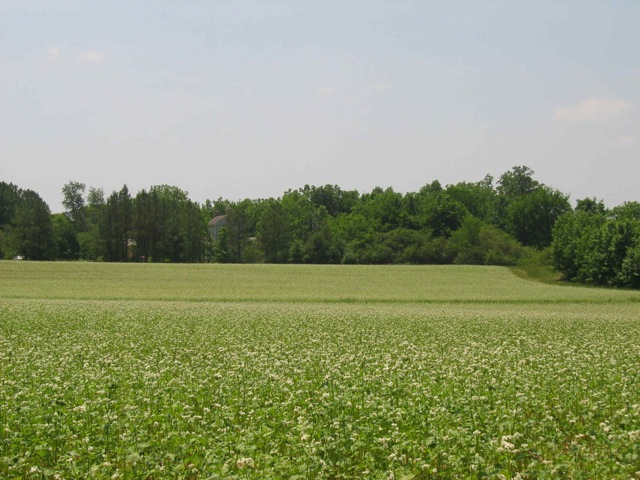 When we bought our Rocky Ford farm property in 1997, it was the culmination of a lifelong dream. We had previously restored an 1858 row house in the historic Spring Garden neighborhood of Philadelphia, but this was different — nearly 55 acres with a stream along side. We named our farm property Lynch Creek, after the stream that I found had more history associated with it than I ever could have imagined. That discovery led me to create the non-profit Ben Franklin Society in 2008 honoring the forgotten Yankee namesake of our county, and then hold fund-raising events through the associated Franklin BreadWorks private dining and entertainment club.
When we bought our Rocky Ford farm property in 1997, it was the culmination of a lifelong dream. We had previously restored an 1858 row house in the historic Spring Garden neighborhood of Philadelphia, but this was different — nearly 55 acres with a stream along side. We named our farm property Lynch Creek, after the stream that I found had more history associated with it than I ever could have imagined. That discovery led me to create the non-profit Ben Franklin Society in 2008 honoring the forgotten Yankee namesake of our county, and then hold fund-raising events through the associated Franklin BreadWorks private dining and entertainment club.
Even though I spend a lot of time indoors cooking, my days include many hours managing the farm using sustainable practices. This outdoors work is a labor of love. Indeed, all my life I’ve been an outdoors type. As a kid, I would fish all day at Gropp’s Lake in Yardville, N.J., riding a bike to the lake from my home. After college, I lived in a Dutch Colonial farmhouse in Middlebush, NJ and played hooky from work to go trout fishing alone in the Delaware Water Gap. It seemed natural to me in 2000 to begin the work necessary to place our farm in permanent conservation easement. Our legal agreement with the local Tar River Land Conservancy was finalized in December 2007. By deed, our property will remain a farm forever, may not be subdivided or developed beyond the needs of a farm, and has a restricted 12-acre stream buffer zone along Lynch Creek.
 In the same time period I began working to secure organic farm certification, which you may imagine was the butt of many jokes in a very traditional Southern farming area in North Carolina’s tobacco country. I vividly recall baffled local farmers scratching their heads with hat in hand as they stopped roadside by my 15- acre field of buckwheat in white blossom. They had never before seen such a cover crop – buckwheat, peas and clover!
In the same time period I began working to secure organic farm certification, which you may imagine was the butt of many jokes in a very traditional Southern farming area in North Carolina’s tobacco country. I vividly recall baffled local farmers scratching their heads with hat in hand as they stopped roadside by my 15- acre field of buckwheat in white blossom. They had never before seen such a cover crop – buckwheat, peas and clover!
Over the years I have fixed fencing, plumbing and electrical problems; built a front pasture storage barn, stream pump and spring house, a woodshop, a chicken coop, a heated greenhouse and unheated high-tunnel, a produce workshop with walk-in cooler, and a vehicle maintenance barn; built our Log Cabin from 100 year old pine logs salvaged from two dismantled tobacco pack houses in Elmo, Va.; and finally, built my wood-fired Pompeii-style brick oven. Only a smokehouse renovation project remains on my to-do list.
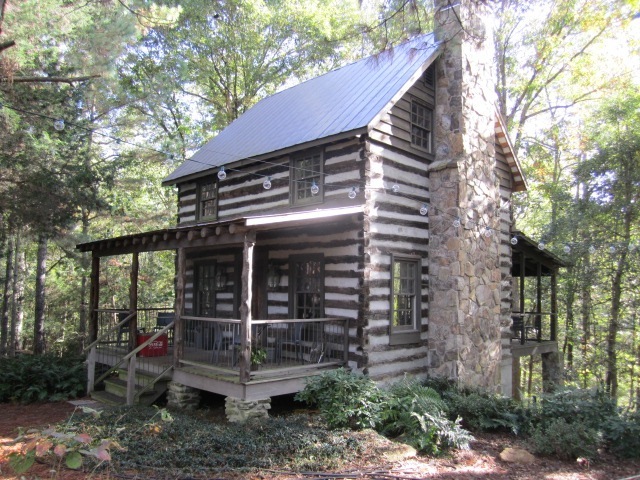 Our Log Cabin was initially to be an antique showroom for my wife, Kerry. It morphed into an artist’s studio, and finally into a business meeting event center when we finally completed construction in December 2012. Construction continued over ten years with many obstacles. If you’re interested, our website, www.lynchcreek.com has posted a month-by-month chronology and photographs of the last four years of my construction work.
Our Log Cabin was initially to be an antique showroom for my wife, Kerry. It morphed into an artist’s studio, and finally into a business meeting event center when we finally completed construction in December 2012. Construction continued over ten years with many obstacles. If you’re interested, our website, www.lynchcreek.com has posted a month-by-month chronology and photographs of the last four years of my construction work.
The site plan we designed (with help from Tim Hanauer of Earth Graphics, Greensboro, NC) around the cabin to control erosion provided the opening I needed to add an outdoor, wood-fired oven. At the time, no one, not even Kerry, comprehended why I was doing this. To me it was simple – not to cook traditional Southern BBQ, but rather to bake Tomato Pie and artisan breads, of course!
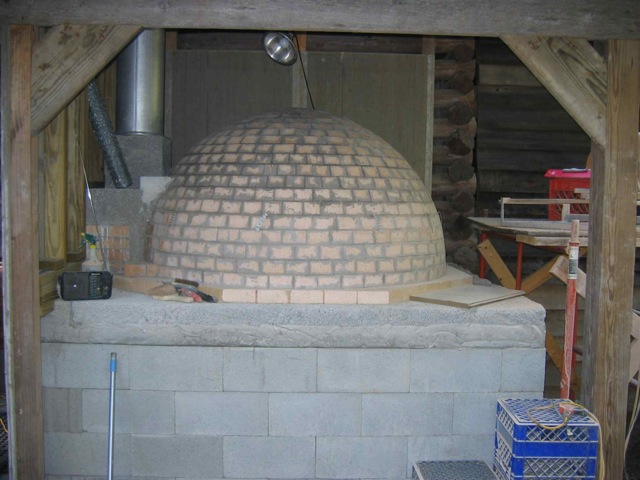 I began building my oven in 2008. The Forno Bravo guideline Pompeii Oven plans were my reference. It was an incredible challenge to build. Its sheer size (56” inside diameter) dwarfs most residential and commercial models. I needed to be sure I could bake two standard sheet trays (18” x 26”) at a time. When I bake breads, I always start my loaves on sheet trays and then transfer them to the oven floor (it’s just too difficult to do otherwise). I use my oven door when I bake breads. It was made by our Pennsylvania friend and expert blacksmith, Ray Mathis (www.tuttometaldesign.com), The Forno Bravo Forum was an incredible resource along the way, but my Yankee ingenuity was required to overcome a few key construction dilemmas:
I began building my oven in 2008. The Forno Bravo guideline Pompeii Oven plans were my reference. It was an incredible challenge to build. Its sheer size (56” inside diameter) dwarfs most residential and commercial models. I needed to be sure I could bake two standard sheet trays (18” x 26”) at a time. When I bake breads, I always start my loaves on sheet trays and then transfer them to the oven floor (it’s just too difficult to do otherwise). I use my oven door when I bake breads. It was made by our Pennsylvania friend and expert blacksmith, Ray Mathis (www.tuttometaldesign.com), The Forno Bravo Forum was an incredible resource along the way, but my Yankee ingenuity was required to overcome a few key construction dilemmas:
· Oven entranceway: I chose to use formwork, not brickwork, to build an arched opening. I also used laminated chimney flue pipe to create the precise, arched door reveal. Special high-temperature concrete mix was required – like that used in pottery kilns.
· Chimney flue transition: I again built a custom form to transition from my rectangular flue opening to my circular double-insulated stainless steel chimney pipe. I used carved Styrofoam that could be chipped-out after the high-temperature concrete cured to expose the flue geometry.
If interested, you can view a slide-show of how I built my wood-fired oven using the web link provided on my Biography page here: https://www.fornobravo.com/pizzaquest/author/bobradcliffe/
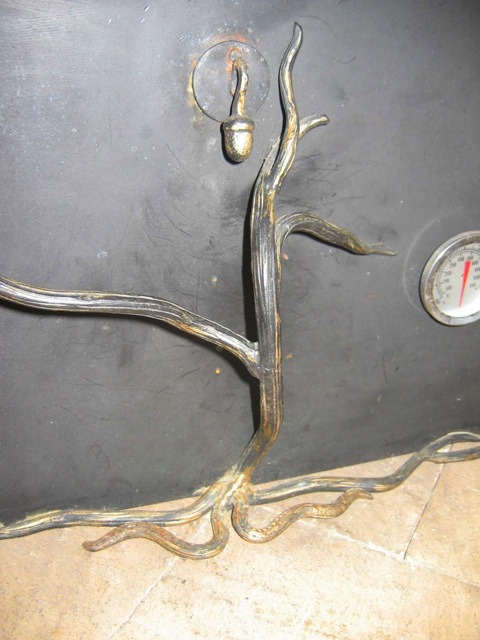 I finally cooked my first Tomato Pie in the Oven on Oct. 24, 2011. We prototyped a handful of BreadWorks events in 2012, and began scheduling monthly BreadWorks Dining and Entertainment events in 2013 at the showplace we have today. To understand how some of the more than 400 Ben Franklin Society BreadWorks community members feel about their headquarters, you can read the comments posted for the articles of this series. We are humbled by the success and support we have received.
I finally cooked my first Tomato Pie in the Oven on Oct. 24, 2011. We prototyped a handful of BreadWorks events in 2012, and began scheduling monthly BreadWorks Dining and Entertainment events in 2013 at the showplace we have today. To understand how some of the more than 400 Ben Franklin Society BreadWorks community members feel about their headquarters, you can read the comments posted for the articles of this series. We are humbled by the success and support we have received.
Indeed our “Field of Dreams” had become a reality – even more than we had envisioned. Kerry often reminds me to “watch what you pray for.” Our property also represents a new sustainable farm model – one integrated with a non-profit entity committed to educational, literary and scientific endeavors. Remarkably, what makes it all work, is food and entertainment – with a blend of farm and public service. Rather than growing food for market, I now grow menu ingredients.
Many have asked me “If you had known how much time and effort it was going to take, would you have begun?” In reply, “I just decide what I want to do, and go do it.” I’ve concluded over the years that I am just wired differently than most. Few contemporaries of mine have ever understood my choices and timing. That’s okay.
Now you understand how long it took, and how difficult it was, before I cooked my first Tomato Pie in Rocky Ford. Let me pass some tips along to you about using such an oven:
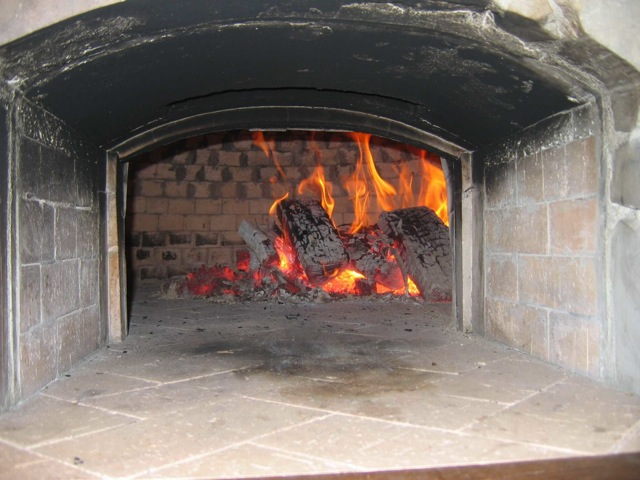 First, let’s talk about firing the oven. As you know, everything passes in-and-out of the oven entrance. With larger diameter ovens like mine, you need a bigger fire. To do that, I start small “Lincoln” log fires (on wooden rails) with a propane torch just under the flue opening in the entranceway, and then slide the log rails into the oven with my metal peel. I usually make at least two, if not three, such fires. I then begin adding split oak wood to gradually create a large fire at the middle of the oven. I burn a vigorous fire for about three hours (until the oven is white hot). I always use oak (hardwood) for what I call the furnace fire that’s solely responsible for heating the oven.
First, let’s talk about firing the oven. As you know, everything passes in-and-out of the oven entrance. With larger diameter ovens like mine, you need a bigger fire. To do that, I start small “Lincoln” log fires (on wooden rails) with a propane torch just under the flue opening in the entranceway, and then slide the log rails into the oven with my metal peel. I usually make at least two, if not three, such fires. I then begin adding split oak wood to gradually create a large fire at the middle of the oven. I burn a vigorous fire for about three hours (until the oven is white hot). I always use oak (hardwood) for what I call the furnace fire that’s solely responsible for heating the oven.
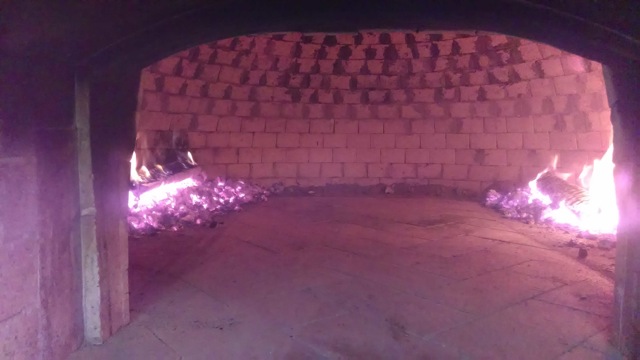 Next, I use a metal hoe to split the fire and push the coals and remaining wood equally to each side creating a center cooking platform. From this point on, I consider these side-fires – flavoring-fires. I optionally use seasoning woods such as hickory, apple, pecan, and even coal, to add another hidden layer of flavor. These fires use smaller pieces of wood, but are essential as you bake Tomato Pie as I do, over several hours, to keep the hot air circulating from the dome above, to the floor below. I continue to experiment with variations of fuel whose smoke flavors my Tomato Pie.
Next, I use a metal hoe to split the fire and push the coals and remaining wood equally to each side creating a center cooking platform. From this point on, I consider these side-fires – flavoring-fires. I optionally use seasoning woods such as hickory, apple, pecan, and even coal, to add another hidden layer of flavor. These fires use smaller pieces of wood, but are essential as you bake Tomato Pie as I do, over several hours, to keep the hot air circulating from the dome above, to the floor below. I continue to experiment with variations of fuel whose smoke flavors my Tomato Pie.
Then, I bake what I call my “sacrificial” pie.
More about that in my next installment – “Philadelphia Style with Carolina Character.” I’ll have more tips about baking, plating, and presenting Tomato Pie and how to deal with leftovers (if any). And yes, gently wind my story down — for now.
Bob
Recent Articles by Bob Radcliffe
Comments
Add Comment
You must be logged in to post a comment.




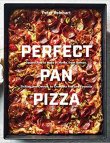
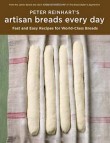
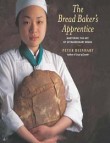
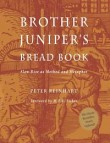
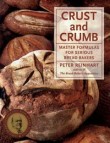
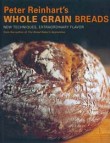
You sell yourself short when you say you are simply wired differently, Bob. I’ve witnessed your creativity, vitality, and life force. What makes you unique is you are able to translate your joy of life and energy into positive, productive action. You honor the earth and your craft with compassion and caring. Your endeavors result in people breaking bread together which is a powerful form of human connection. Keep up the wonderful work!
Filomena D. Warihay, Ph.D.
Anyway, all of us love top10, high 20 lists, so here
I present you the highest 30 Australia meals blogs.